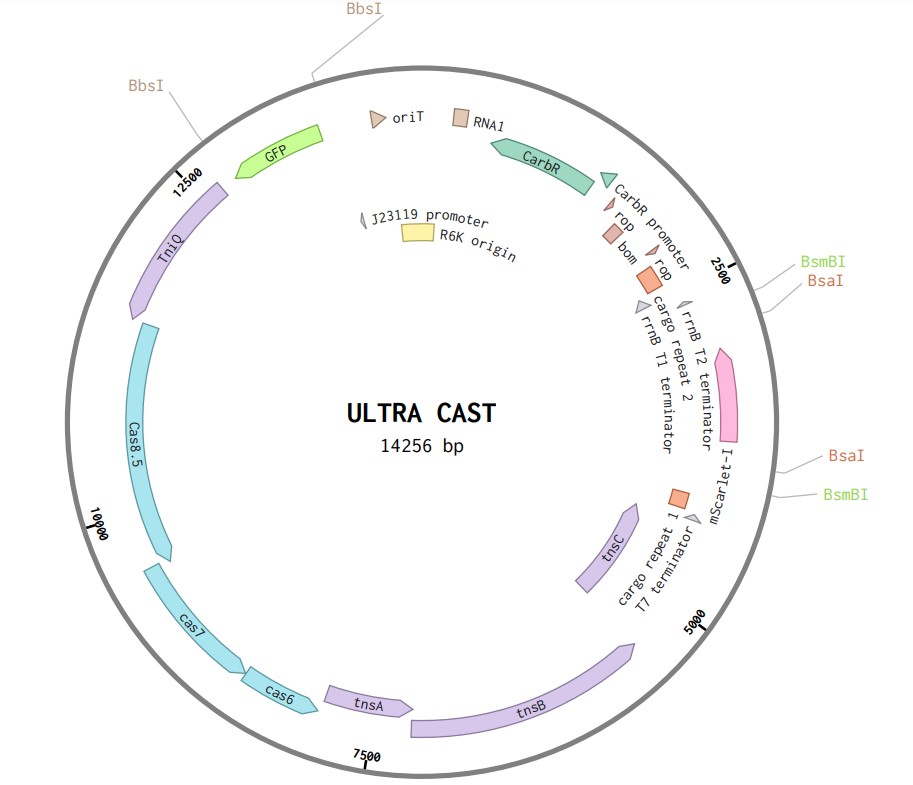CRISPR Associated Transposons (CASTs)
The CRISPR Associated Transposon system allows for the targeted insertion of a large genetic cargo (up to 10 kb) into a bacterial genome roughly 50 bp downstream of where a 32 bp spacer sequence matches that genome. The system described here is based off of the Type I-F originally from Vibrio cholerae and can be used for a variety of applications. To become familiar with CRISPR Associated Transposons, it is recommended that you read the following papers as a primer: Hu et al. 2023, Klompe et al. 2019, Vo et al. 2021. The CAST system is encoded on the following plasmid which is Golden Gate compatible and contains a two dropouts: a GFP dropout with BbsI cut sites for the insertion of a spacer sequence and a mScarlet dropout with both BsmB1 (compatible with ConRE and ConLS overhangs) and BsaI (compatible with type 2-4 overhangs) cut sites. To design a spacer sequence, scan the genome for the PAM sequence 5'-CC-3'. Next, copy the preceding 32 bp sequence and add the following sequences:
At the 5' end of the spacer: GCATGAAGACAAaaactgaactgccgagtaggtagctgataac.
At the 3' end of the spacer: gtgaactgccgagtaggtagctgataaatggGTGTCTTCGCAT.
Keep in mind when designing the spacer sequence that the cargo will insert 50 bp DOWNSTREAM from the end of where the spacer sequence matches the genome.
Once you have successfully cloned your spacer and cargo sequence into the CAST vector, transform into E. coli pir+ cells for sequencing. Next, extract the plasmid and transform into MFDpir E. coli cells before delivering the plasmid to the target cells via bacterial conjugation.
This plasmid has an R6K backbone, meaning that it can only replicate in pir-dependent bacterial cells. Once conjugated into the target strain, there is no need for curing as the plasmid will not replicate.
To design a spacer sequence, scan the genome for the PAM sequence 5'-CC-3'. Next, copy the preceding 32 bp sequence and add the following sequences:
At the 5' end of the spacer: GCATGAAGACAAaaactgaactgccgagtaggtagctgataac.
At the 3' end of the spacer: gtgaactgccgagtaggtagctgataaatggGTGTCTTCGCAT.
Keep in mind when designing the spacer sequence that the cargo will insert 50 bp DOWNSTREAM from the end of where the spacer sequence matches the genome.
Once you have successfully cloned your spacer and cargo sequence into the CAST vector, transform into E. coli pir+ cells for sequencing. Next, extract the plasmid and transform into MFDpir E. coli cells before delivering the plasmid to the target cells via bacterial conjugation.
This plasmid has an R6K backbone, meaning that it can only replicate in pir-dependent bacterial cells. Once conjugated into the target strain, there is no need for curing as the plasmid will not replicate. | I | Attachment | History | Action | Size | Date | Who | Comment |
|---|---|---|---|---|---|---|---|
| |
CAST_pic.jpg | r1 | manage | 70.5 K | 2024-04-09 - 21:47 | AnthonyVandieren | CAST_pic |
Barrick Lab > ProtocolList > ProtocolsCRISPRAssociatedTransposons(CASTs)
Topic revision: r1 - 2024-04-09 - 21:48:47 - Main.AnthonyVandieren

